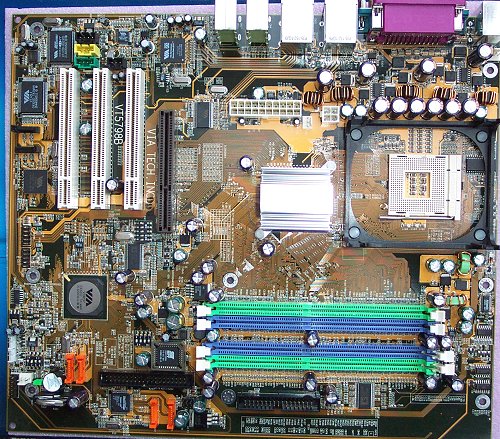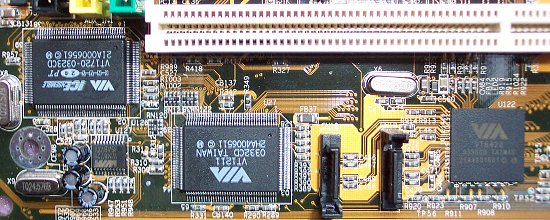Reference board
The reference motherboard is worth a look as it tries to cram as many VIA features into a single board as possible.
We'll not spend time discussing the layout. This isn't a board that will hit retail shelves. It's simply a PCB demonstration of VIA's engineering skills. The PT880 hides underneath a passive heatsink. We hope that retail models will do the same. With careful engineering and component selection, one can build a powerful PC that doesn't feature highly on the decibel scale. A passive heatsink is the way to go.
Notice how the 4 DIMM slots are colour coded, yet dual-channel running is routed differently from i865 / i875 boards. Slots of the same colour make up a DC configuration, so you'll need to use the outer or inner slots, or both. Maximum memory support is quoted as 8GB. We reckon 2GB is the acceptable maximum in a home environment.

Here's what I was referring to on the previous page. VIA has chosen to use up all 4 on-chip SATA ports at the expense of a PATA channel. Note the Silicon Image physical layer to the right of the primary channel ?. That adds the aforementioned on-chip support for the two SATA ports you see just above it. It also adds in RAID0+1 ability. Your primary storage would almost have to be SATA in this case, otherwise you'd be hard pushed to connect up optical drives.

The reference PT880 goes all out for SATA storage. VIA adds in the VT6420 SATA controller and another 2 SATA ports into the equation. These, naturally, run off the PCI bus and are thus subject to its limitations. The lovely PCI-based Envy24PT makes an appearance here, too, and we'd wish that it would grace a greater number of retail motherboards.

VIA adds in the VT1616 audio CODEC, too, and thus duplicates the board's sound ability, although the sonic skills of the '1616 falls appreciably short of the Envy's. VIA doubles up again with dual LAN, one is run from a standard VIA Integrated Fast Ethernet controller and PHY, the other is the PCI-driven VIA Velocity Ethernet controller (VT6120). It's specified to excel in conditions with excessive line noise, and it's also equipped with decent monitoring software.

A weird and wonderful I/O section. Duplicate sound and LAN ports make it an oddity, but, hey, it's reference material. We wonder why VIA didn't add in its well-used VT6307 FireWire controller here. However, the idea here was to showcase the chipset's talents.









